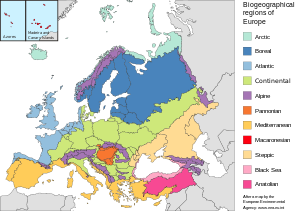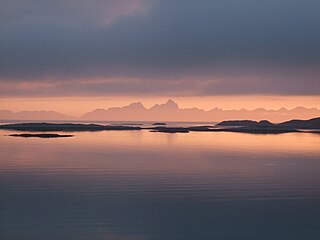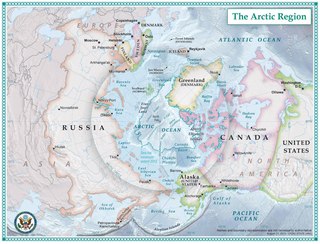| Arctic Biogeographic Region | |
|---|---|
 Spitsbergen, | |
 | |
| Ecology | |
| Realm | Palearctic |
| Geography | |
| Oceans or seas | Arctic Ocean |
The European Arctic Biogeographic Region is the biogeographic region of Europe around and in the Arctic Ocean.
| Arctic Biogeographic Region | |
|---|---|
 Spitsbergen, | |
 | |
| Ecology | |
| Realm | Palearctic |
| Geography | |
| Oceans or seas | Arctic Ocean |
The European Arctic Biogeographic Region is the biogeographic region of Europe around and in the Arctic Ocean.
The European Commission and the Council of Europe have defined the European Arctic biogeographical region for the purpose of reporting on conservation efforts and results. The region includes Iceland and parts of Norway and Russia, including Svalbard (Spitsbergen), Franz Josef Land and Novaya Zemlya. It has a land area of 670,000 square kilometres (260,000 sq mi), of which 63% is in Russia, 22% in Norway and 15% in Iceland. About 60% of the land is covered by grassland and tundra. [1]
The region has a wide variety of landscapes, and includes some of the last remaining large wilderness areas in Europe. Many of the land areas are coastal, strongly affected by exchange with the sea. Large areas are ice-covered, and many areas have permafrost, creating demanding conditions for plants and animals. Most species are dormant in winter, but large number of plants and animals are active in the warmer months. There are many species of migrating birds and fish, common to all the polar regions. [2]
The environment is affected by air pollution from distant sources. Some areas have been affected by overgrazing, and are now being affected by tourism. Global warming will force species to move northward or to higher elevations, and may cause some extinctions. [2]

The Arctic fox, also known as the white fox, polar fox, or snow fox, is a small fox native to the Arctic regions of the Northern Hemisphere and common throughout the Arctic tundra biome. It is well adapted to living in cold environments, and is best known for its thick, warm fur that is also used as camouflage. In the wild, most individuals do not live past their first year but some exceptional ones survive up to 11 years. Its body length ranges from 46 to 68 cm, with a generally rounded body shape to minimize the escape of body heat.

The Norwegian Sea is a marginal sea in the Arctic Ocean, northwest of Norway between the North Sea and the Greenland Sea, adjoining the Barents Sea to the northeast. In the southwest, it is separated from the Atlantic Ocean by a submarine ridge running between Iceland and the Faroe Islands. To the north, the Jan Mayen Ridge separates it from the Greenland Sea.

The Scandinavian Peninsula is a peninsula of Eurasia located in Northern Europe, which roughly comprises the mainland of Sweden, the mainland of Norway, and the northwestern area of Finland.

In physical geography, tundra is a type of biome where the tree growth is hindered by low temperatures and short growing seasons. The term tundra comes through Russian тундра from the Kildin Sámi word тӯндар meaning "uplands", "treeless mountain tract". Tundra vegetation is composed of dwarf shrubs, sedges and grasses, mosses, and lichens. Scattered trees grow in some tundra regions. The ecotone between the tundra and the forest is known as the tree line or timberline. The tundra soil is rich in nitrogen and phosphorus.

The Arctic is a polar region located at the northernmost part of Earth. The Arctic consists of the Arctic Ocean, adjacent seas, and parts of Alaska, Finland, Greenland (Denmark), Iceland, Northern Canada, Norway, Russia, and Sweden. Land within the Arctic region has seasonally varying snow and ice cover, with predominantly treeless permafrost containing tundra. Arctic seas contain seasonal sea ice in many places.

Norway is a country located in Northern Europe on the northern and western parts of the Scandinavian Peninsula. The majority of the country borders water, including the Skagerrak inlet to the south, the North Sea to the southwest, the North Atlantic Ocean to the west, and the Barents Sea to the north. It has a land border with Sweden to the east and a shorter border with Finland and an even shorter border with Russia to the northeast.

The Palearctic or Palaearctic is one of the eight biogeographic realms on the Earth's surface, first identified in the 19th century, and is still in use as the basis for zoogeographic classification. The Palearctic is the largest of the eight realms. It stretches across all of Europe, Asia north of the foothills of the Himalayas, North Africa, and the northern and central parts of the Arabian Peninsula.

The Holarctic is the name for the biogeographic realm that encompasses the majority of habitats found throughout the northern continents of the world, combining Wallace's Palearctic zoogeographical region, consisting of North Africa and all of Eurasia, and the Nearctic zoogeographical region, consisting of North America, north of Mexico. These regions are further subdivided into a variety of ecoregions. Many ecosystems, and the animal and plant communities that depend on them, are found across multiple continents in large portions of this realm. The continuity of these ecosystems results from the shared glacial history of the realm. The floristic Boreal Kingdom corresponds to the Holarctic realm.
Polar ecology is the relationship between plants and animals in a polar environment. Polar environments are in the Arctic and Antarctic regions. Arctic regions are in the Northern Hemisphere, and it contains land and the islands that surrounds it. Antarctica is in the Southern Hemisphere and it also contains the land mass, surrounding islands and the ocean. Polar regions also contain the subantarctic and subarctic zone which separate the polar regions from the temperate regions. Antarctica and the Arctic lie in the polar circles. The polar circles are not visible on the earth but it is shown on maps to be the areas that receives less sunlight due to less radiation. These areas either receive sunlight or shade 24 hours a day because of the earth's tilt. Plants and animals in the polar regions are able to withstand living in harsh weather conditions but are facing environmental threats that limit their survival.
The Bølling–Allerød interstadial was an abrupt warm and moist interstadial period that occurred during the final stages of the last glacial period. This warm period ran from c. 14,700 to c. 12,700 years before the present (BP). It began with the end of the cold period known as the Oldest Dryas, and ended abruptly with the onset of the Younger Dryas, a cold period that reduced temperatures back to near-glacial levels within a decade.

Arctic ecology is the scientific study of the relationships between biotic and abiotic factors in the arctic, the region north of the Arctic Circle. This region is characterized by stressful conditions as a result of extreme cold, low precipitation, a limited growing season and virtually no sunlight throughout the winter. The Arctic consists of taiga and tundra biomes, which also dominate very high elevations, even in the tropics. Sensitive ecosystems exist throughout the Arctic region, which are being impacted dramatically by global warming. The earliest inhabitants of the Arctic were the Neanderthal sub-species. Since then, many indigenous populations have inhabited the region, which continues to this day. Since the early 1900s, when Vilhjalmur Stefansson led the first major Canadian Arctic Expedition, the Arctic has been a valued area for ecological research. In 1946, The Arctic Research Laboratory was established in Point Barrow, Alaska under the contract of the Office of Naval Research. This launched an interest in exploring the Arctic examining animal cycles, permafrost and the interactions between indigenous peoples and the Arctic ecology. During the Cold War, the Arctic became a place where the United States, Canada, and the Soviet Union performed significant research that has been essential to the study of climate change in recent years. A major reason why research in the Arctic is essential for the study of climate change is because the effects of climate change will be felt more quickly and more drastically in higher latitudes of the world as above average temperatures are predicted for Northwest Canada and Alaska. From an anthropological point of view, researchers study the native Inuit peoples of Alaska as they have become extremely accustomed to adapting to ecological and climate variability.

The fauna of Europe is all the animals living in Europe and its surrounding seas and islands. Since there is no natural biogeographic boundary in the east and south between Europe and Asia, the term "fauna of Europe" is somewhat elusive. Europe is the western part of the Palearctic ecozone. Lying within the temperate region, the wildlife is not as rich as in the hottest regions, but is nevertheless diverse due to the variety of habitats and the faunal richness of Eurasia as a whole.

The Arctic Ocean is the smallest and shallowest of the world's five major oceans. It is also known as the coldest of all the oceans. The International Hydrographic Organization (IHO) recognizes it as an ocean, although some oceanographers call it the Arctic Sea. It is sometimes classified as an estuary of the Atlantic Ocean, and it is also seen as the northernmost part of the all-encompassing World Ocean.

Svalbard is a Norwegian archipelago in the Arctic Ocean. The climate of Svalbard is principally a result of its latitude, which is between 74° and 81° north. Climate is defined by the World Meteorological Organization as the average weather over a 30-year period. The North Atlantic Current moderates Svalbard's temperatures, particularly during winter, giving it up to 20 °C (36 °F) higher winter temperature than similar latitudes in continental Russia and Canada. This keeps the surrounding waters open and navigable most of the year. The interior fjord areas and valleys, sheltered by the mountains, have less temperature differences than the coast, with about 2 °C lower summer temperatures and 3 °C higher winter temperatures. On the south of the largest island, Spitsbergen, the temperature is slightly higher than further north and west. During winter, the temperature difference between south and north is typically 5 °C, and about 3 °C in summer. Bear Island (Bjørnøya) has average temperatures even higher than the rest of the archipelago.

The Canadian Arctic tundra is a biogeographic designation for Northern Canada's terrain generally lying north of the tree line or boreal forest, that corresponds with the Scandinavian Alpine tundra to the east and the Siberian Arctic tundra to the west inside the circumpolar tundra belt of the Northern Hemisphere.

The Arctic desert ecoregion is a terrestrial ecoregion that covers the island groups of Svalbard, Franz Josef Land, Severny Island and Severnaya Zemlya in the Arctic Ocean, above 75 degrees north latitude. e covered with glaciers, snow, and bare rock in a harshly cold environment. The temperature does rise above freezing for short periods in the summer, so some ice melt occurs, and the area supports colonies of sea birds and mammals. It has an area of 161,356 square kilometres (62,300 sq mi).

The wildlife of Norway includes the diverse flora and fauna of Norway. The native plants and animals are adapted to the geography and climate of this country in northwestern Europe. The habitats include high mountains, tundras, rivers, lakes, wetlands, sea coast and some lower cultivated land in the south. Mainland Norway has a long coastline, protected by skerries and much dissected by fjords, and the mostly-icebound archipelago of Svalbard lies further north. The flora is very varied and a large range of mammals, birds, fish and invertebrate species live here, as well as a few species of reptiles and amphibians.

The Mediterranean Biogeographic Region is the biogeographic region around and including the Mediterranean Sea. The term is defined by the European Environment Agency as applying to the land areas of Europe that border on the Mediterranean Sea, and the corresponding territorial waters. The region is rich in biodiversity and has many endemic species. The term may also be used in the broader sense of all the lands of the Mediterranean Basin, or in the narrow sense of just the Mediterranean Sea.

The Boreal Biogeographic Region is the biogeographic region of Northern Europe that consists primarily of coniferous forests and wetlands.

The Anatolian Biogeographic Region is a biogeographic region of Turkey, as defined by the European Environment Agency.